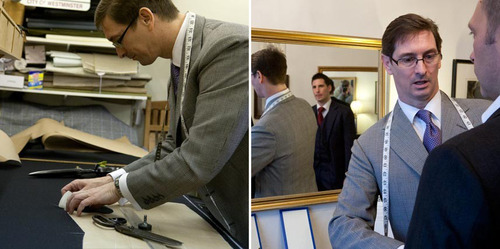When we spoke to Edwin DeBoise last week about how he creates double-breasted jackets, he touched on a technique called “straightening a coat.” A complicated process involving things such as “neckpoints” and “balance,” it was difficult to convey using just words. As Edwin told me over the phone, when he was first taught the technique by Edward Sexton (the famous Savile Row cutter behind Tommy Nutter), they were sitting at a bar and Edward had to use napkins. “It’s difficult to understand because when you explain it, your mind is telling you things should be the exact opposite of what’s happening,” Edwin said.
Fortunately for us, Edwin and his son Matthew agreed to film this video for our readers, where Edwin demonstrates the technique. And he’s not using bar napkins, but rather a paper pattern for one his clients at Steed Bespoke Tailors (the custom tailoring house he owns and runs).
Getting the Jacket to Hang Right: A Matter of Balance
Straightening a coat, and its inverse crookening, are two techniques used to help achieve “balance” – which is tailoring-speak for how a jacket hangs. More than just how the chest and shoulders fit, a properly tailored jacket should also hang properly. That means the jacket’s front hem ought to be level with the back hem when the garment is viewed from the side. Some tailors will make the front longer than the back (Edwin says they used to do this more at Anderson & Sheppard because of their longer lapel roll), but all tailors agree: the front should never be shorter than the back when the jacket is worn.
So, to ensure that a jacket hangs correctly, a tailor might add length to the front or back of a jacket, depending on the wearer’s figure (tailors call this adding front or back balance). And depending on their posture, a tailor might also straighten or crooken a coat. Edwin explains both procedures in the video above.

What this Means for You
Granted, if you have a bespoke tailor, these technicalities should be taken care for you in the backrooms. This isn’t info you need to know, although it’s fun to learn. However, what does this mean if you buy ready-to-wear?
- Take a Side View: When trying on a jacket, view it from the side. Again, the front can hang a bit lower than the back, or sit evenly with it. It just shouldn’t ride up and be shorter (at least on a traditionally tailored coat).
- Stand Naturally: “People tend to stand overly erect when they’re in front of a camera or mirror,” says Edwin. “In order to see if the jacket hangs right, however, you have to stand naturally.”
- Can You Alter?: Bad news, if a jacket’s balance doesn’t work for you off-the-rack, it can’t be altered to fit. Just move on and try something else.
Big, warm thanks to Steed for creating this video for us. For those interested in their bespoke and made-to-measure tailoring services, check them out next week when they visit seven US cities. Their US tour starts February 10th and they’ll return every four months. I’ve been a client of theirs for years now (everything paid full price; no secret blogger-discounts) and couldn’t recommend them more highly. They specialize in a soft, English style of tailoring known as a drape cut, where soft, minimally-padded shoulders are combined with a fuller chest and nicely-nipped waist. You can see examples of their work at Voxsartoria.